Hyundai Terracan 2005 Owner's Manual
Manufacturer: HYUNDAI, Model Year: 2005, Model line: Terracan, Model: Hyundai Terracan 2005Pages: 539, PDF Size: 18.03 MB
Page 421 of 539
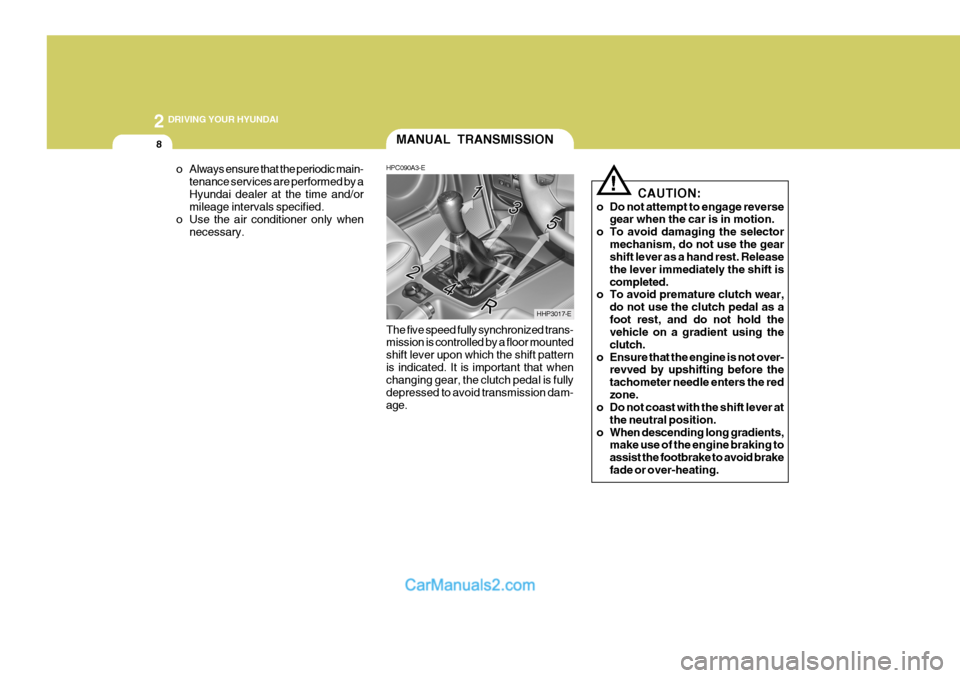
2 DRIVING YOUR HYUNDAI
8
!
o Always ensure that the periodic main-
tenance services are performed by a Hyundai dealer at the time and/or mileage intervals specified.
o Use the air conditioner only when
necessary.
The five speed fully synchronized trans-mission is controlled by a floor mounted shift lever upon which the shift patternis indicated. It is important that when changing gear, the clutch pedal is fully depressed to avoid transmission dam-age. CAUTION:
o Do not attempt to engage reverse gear when the car is in motion.
o To avoid damaging the selector mechanism, do not use the gear shift lever as a hand rest. Release the lever immediately the shift iscompleted.
o To avoid premature clutch wear,
do not use the clutch pedal as afoot rest, and do not hold the vehicle on a gradient using the clutch.
o Ensure that the engine is not over- revved by upshifting before thetachometer needle enters the redzone.
o Do not coast with the shift lever at
the neutral position.
o When descending long gradients, make use of the engine braking toassist the footbrake to avoid brakefade or over-heating.
MANUAL TRANSMISSION
HHP3017-E
HPC090A3-E
Page 422 of 539
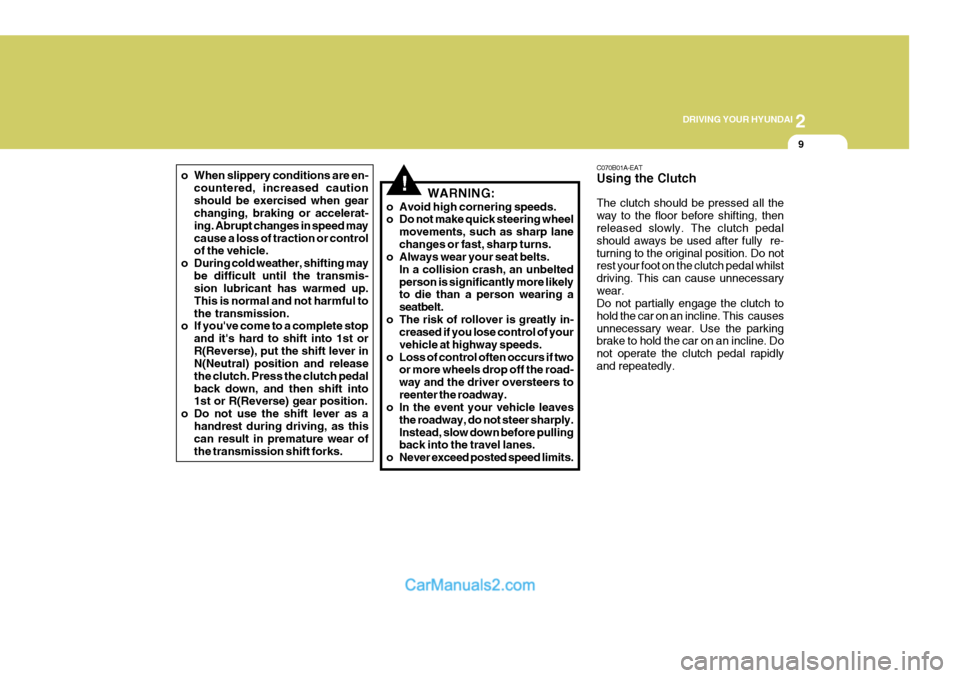
2
DRIVING YOUR HYUNDAI
9
o When slippery conditions are en-
countered, increased caution should be exercised when gear changing, braking or accelerat- ing. Abrupt changes in speed maycause a loss of traction or control of the vehicle.
o During cold weather, shifting may be difficult until the transmis-sion lubricant has warmed up. This is normal and not harmful tothe transmission.
o If you've come to a complete stop
and it's hard to shift into 1st orR(Reverse), put the shift lever in N(Neutral) position and release the clutch. Press the clutch pedalback down, and then shift into 1st or R(Reverse) gear position.
o Do not use the shift lever as a handrest during driving, as thiscan result in premature wear of the transmission shift forks. C070B01A-EAT Using the Clutch The clutch should be pressed all the way to the floor before shifting, then released slowly. The clutch pedal should aways be used after fully re-turning to the original position. Do not rest your foot on the clutch pedal whilst driving. This can cause unnecessarywear. Do not partially engage the clutch to hold the car on an incline. This causesunnecessary wear. Use the parking brake to hold the car on an incline. Do not operate the clutch pedal rapidlyand repeatedly.
!WARNING:
o Avoid high cornering speeds.
o Do not make quick steering wheel movements, such as sharp lane changes or fast, sharp turns.
o Always wear your seat belts.
In a collision crash, an unbeltedperson is significantly more likely to die than a person wearing a seatbelt.
o The risk of rollover is greatly in- creased if you lose control of yourvehicle at highway speeds.
o Loss of control often occurs if two or more wheels drop off the road-way and the driver oversteers toreenter the roadway.
o In the event your vehicle leaves
the roadway, do not steer sharply.Instead, slow down before pulling back into the travel lanes.
o Never exceed posted speed limits.
Page 423 of 539
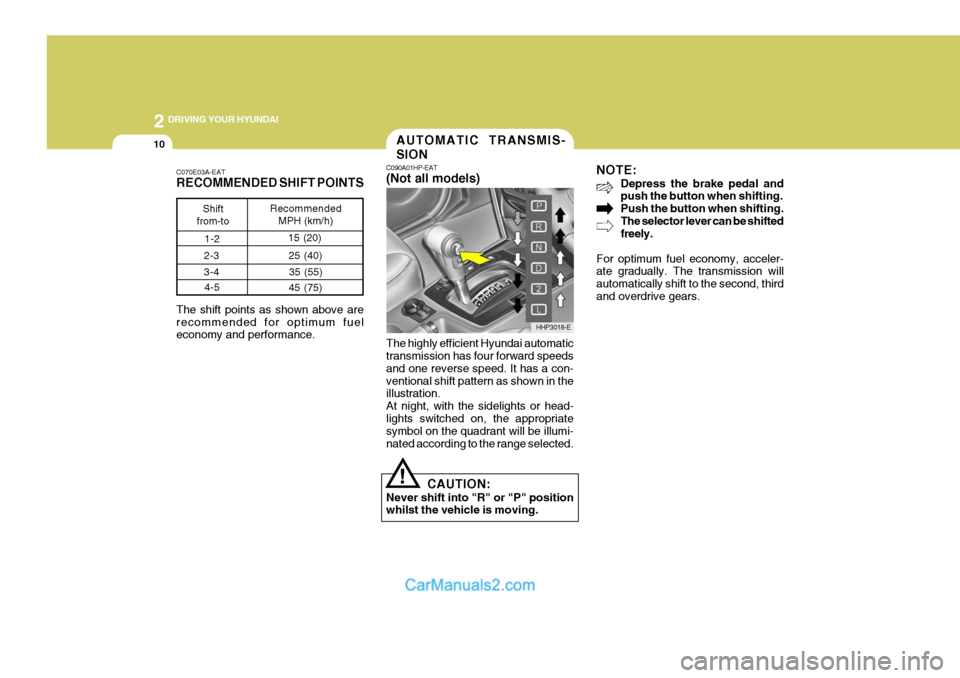
2 DRIVING YOUR HYUNDAI
10
!
The highly efficient Hyundai automatic transmission has four forward speeds and one reverse speed. It has a con-ventional shift pattern as shown in the illustration. At night, with the sidelights or head-lights switched on, the appropriate symbol on the quadrant will be illumi- nated according to the range selected. NOTE:
Depress the brake pedal and push the button when shifting. Push the button when shifting.The selector lever can be shifted freely.
For optimum fuel economy, acceler-ate gradually. The transmission will automatically shift to the second, thirdand overdrive gears.
CAUTION:
Never shift into "R" or "P" position whilst the vehicle is moving.
C070E03A-EAT RECOMMENDED SHIFT POINTS The shift points as shown above are recommended for optimum fuel economy and performance.
Shift
from-to Recommended
MPH (km/h)
AUTOMATIC TRANSMIS- SION
C090A01HP-EAT (Not all models)
HHP3018-E
1-2
15 (20)
2-3 3-4 4-5 25 (40)
35 (55)
45 (75)
Page 424 of 539
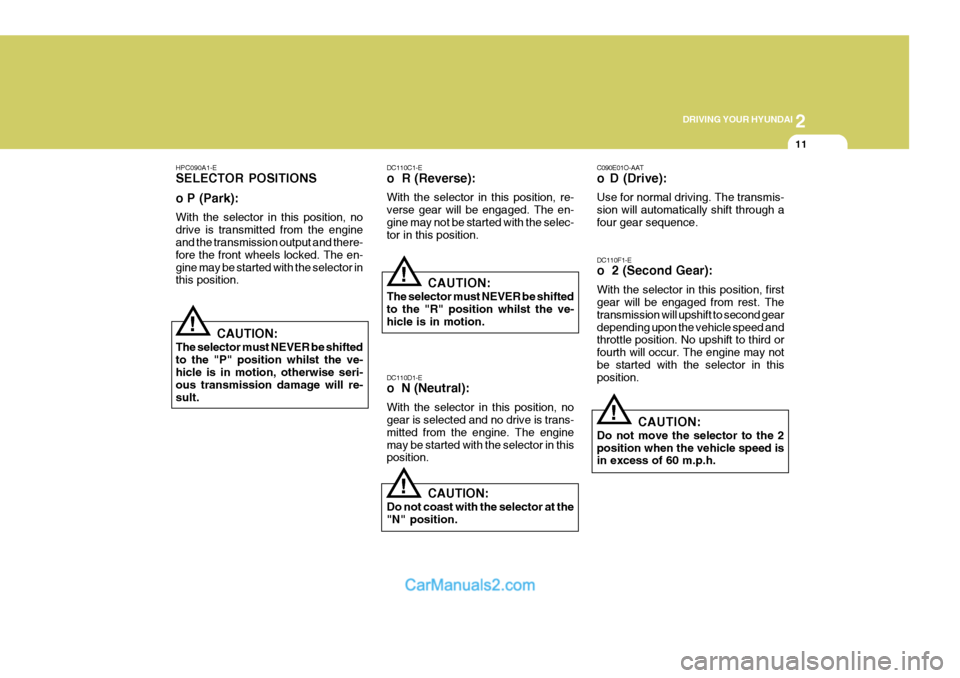
2
DRIVING YOUR HYUNDAI
11
!
HPC090A1-E SELECTOR POSITIONS o P (Park): With the selector in this position, no drive is transmitted from the engine and the transmission output and there- fore the front wheels locked. The en-gine may be started with the selector in this position.
CAUTION:
The selector must NEVER be shifted to the "P" position whilst the ve- hicle is in motion, otherwise seri- ous transmission damage will re-sult.
!
!
!
DC110C1-E o R (Reverse): With the selector in this position, re- verse gear will be engaged. The en-gine may not be started with the selec- tor in this position.
CAUTION:
The selector must NEVER be shifted to the "R" position whilst the ve-hicle is in motion. DC110D1-E o N (Neutral): With the selector in this position, no gear is selected and no drive is trans- mitted from the engine. The enginemay be started with the selector in this position.
CAUTION:
Do not coast with the selector at the "N" position. C090E01O-AAT
o D (Drive): Use for normal driving. The transmis- sion will automatically shift through afour gear sequence. DC110F1-E o 2 (Second Gear): With the selector in this position, first gear will be engaged from rest. The transmission will upshift to second geardepending upon the vehicle speed and throttle position. No upshift to third or fourth will occur. The engine may notbe started with the selector in this position.
CAUTION:
Do not move the selector to the 2 position when the vehicle speed is in excess of 60 m.p.h.
Page 425 of 539
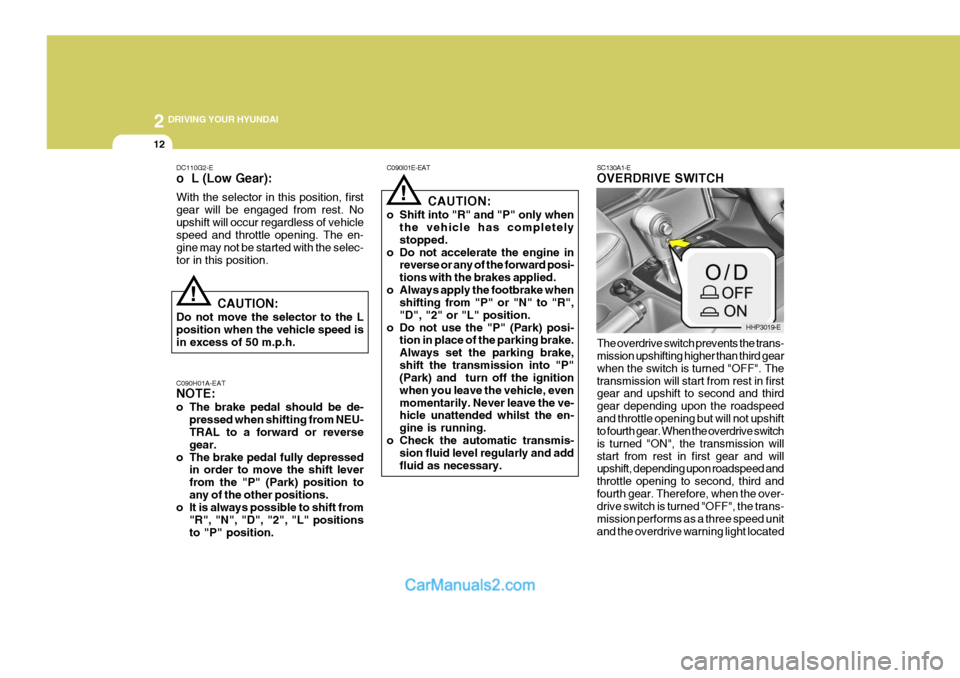
2 DRIVING YOUR HYUNDAI
12
!
C090I01E-EAT
CAUTION:
o Shift into "R" and "P" only when the vehicle has completely stopped.
o Do not accelerate the engine in reverse or any of the forward posi-tions with the brakes applied.
o Always apply the footbrake when shifting from "P" or "N" to "R","D", "2" or "L" position.
o Do not use the "P" (Park) posi- tion in place of the parking brake.Always set the parking brake,shift the transmission into "P" (Park) and turn off the ignition when you leave the vehicle, evenmomentarily. Never leave the ve- hicle unattended whilst the en- gine is running.
o Check the automatic transmis- sion fluid level regularly and addfluid as necessary. SC130A1-E OVERDRIVE SWITCH The overdrive switch prevents the trans- mission upshifting higher than third gear when the switch is turned "OFF". Thetransmission will start from rest in first gear and upshift to second and third gear depending upon the roadspeedand throttle opening but will not upshift to fourth gear. When the overdrive switch is turned "ON", the transmission willstart from rest in first gear and will upshift, depending upon roadspeed and throttle opening to second, third andfourth gear. Therefore, when the over- drive switch is turned "OFF", the trans- mission performs as a three speed unitand the overdrive warning light located
!
DC110G2-E o L (Low Gear): With the selector in this position, first gear will be engaged from rest. Noupshift will occur regardless of vehicle speed and throttle opening. The en- gine may not be started with the selec-tor in this position.
CAUTION:
Do not move the selector to the Lposition when the vehicle speed isin excess of 50 m.p.h. C090H01A-EAT NOTE:
o The brake pedal should be de- pressed when shifting from NEU- TRAL to a forward or reverse gear.
o The brake pedal fully depressed in order to move the shift leverfrom the "P" (Park) position toany of the other positions.
o It is always possible to shift from
"R", "N", "D", "2", "L" positionsto "P" position.
HHP3019-E
Page 426 of 539
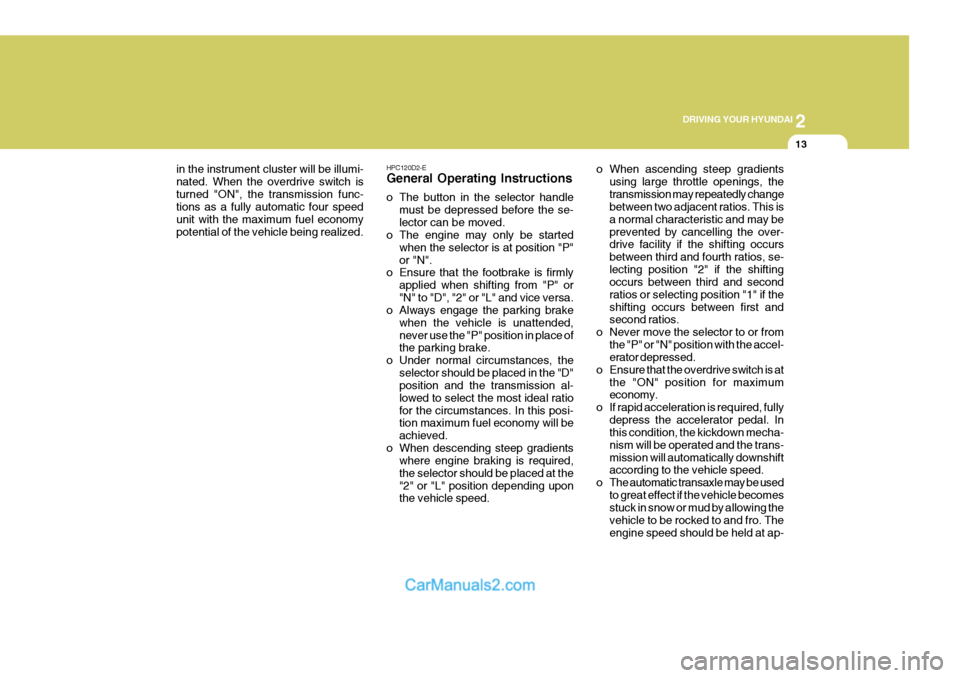
2
DRIVING YOUR HYUNDAI
13
in the instrument cluster will be illumi- nated. When the overdrive switch isturned "ON", the transmission func- tions as a fully automatic four speed unit with the maximum fuel economypotential of the vehicle being realized. HPC120D2-E General Operating Instructions
o The button in the selector handle
must be depressed before the se- lector can be moved.
o The engine may only be started
when the selector is at position "P"or "N".
o Ensure that the footbrake is firmly
applied when shifting from "P" or"N" to "D", "2" or "L" and vice versa.
o Always engage the parking brake
when the vehicle is unattended,never use the "P" position in place of the parking brake.
o Under normal circumstances, the selector should be placed in the "D"position and the transmission al- lowed to select the most ideal ratiofor the circumstances. In this posi- tion maximum fuel economy will be achieved.
o When descending steep gradients where engine braking is required,the selector should be placed at the"2" or "L" position depending upon the vehicle speed. o When ascending steep gradients
using large throttle openings, the transmission may repeatedly change between two adjacent ratios. This is a normal characteristic and may beprevented by cancelling the over- drive facility if the shifting occurs between third and fourth ratios, se-lecting position "2" if the shifting occurs between third and second ratios or selecting position "1" if theshifting occurs between first and second ratios.
o Never move the selector to or from the "P" or "N" position with the accel-erator depressed.
o Ensure that the overdrive switch is at the "ON" position for maximumeconomy.
o If rapid acceleration is required, fully depress the accelerator pedal. Inthis condition, the kickdown mecha- nism will be operated and the trans-mission will automatically downshift according to the vehicle speed.
o The automatic transaxle may be used to great effect if the vehicle becomesstuck in snow or mud by allowing the vehicle to be rocked to and fro. Theengine speed should be held at ap-
Page 427 of 539
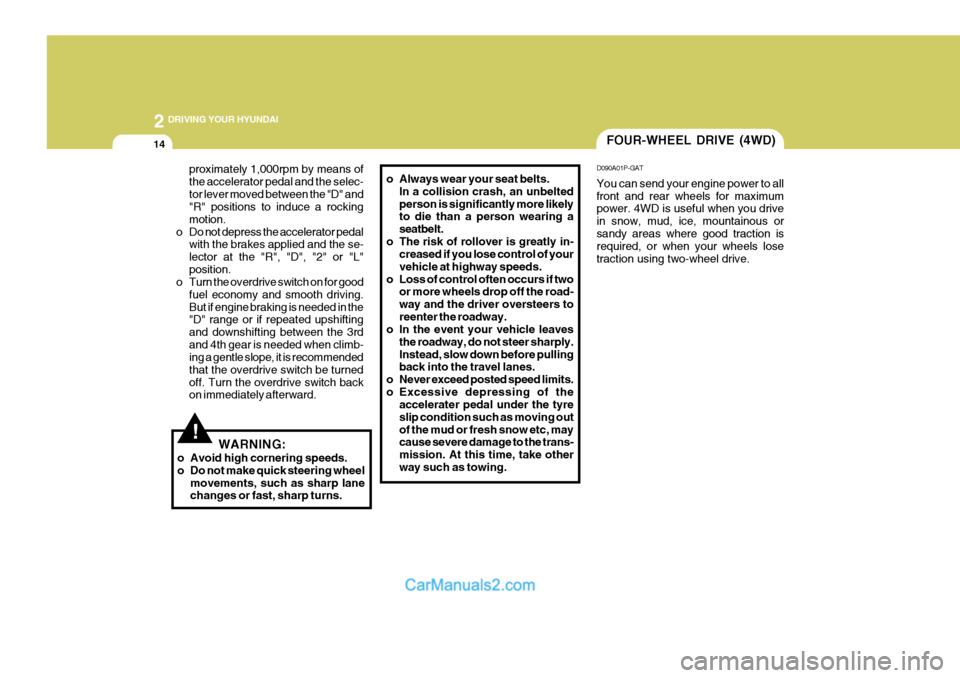
2 DRIVING YOUR HYUNDAI
14FOUR-WHEEL DRIVE (4WD)
D090A01P-GAT You can send your engine power to all front and rear wheels for maximum power. 4WD is useful when you drive in snow, mud, ice, mountainous orsandy areas where good traction is required, or when your wheels lose traction using two-wheel drive.
proximately 1,000rpm by means ofthe accelerator pedal and the selec-tor lever moved between the "D" and "R" positions to induce a rocking motion.
o Do not depress the accelerator pedal with the brakes applied and the se-lector at the "R", "D", "2" or "L"position.
o Turn the overdrive switch on for good
fuel economy and smooth driving.But if engine braking is needed in the "D" range or if repeated upshifting and downshifting between the 3rdand 4th gear is needed when climb- ing a gentle slope, it is recommended that the overdrive switch be turnedoff. Turn the overdrive switch back on immediately afterward.
!WARNING:
o Avoid high cornering speeds.
o Do not make quick steering wheel movements, such as sharp lane changes or fast, sharp turns. o Always wear your seat belts.
In a collision crash, an unbelted person is significantly more likely to die than a person wearing a seatbelt.
o The risk of rollover is greatly in- creased if you lose control of yourvehicle at highway speeds.
o Loss of control often occurs if two or more wheels drop off the road-way and the driver oversteers toreenter the roadway.
o In the event your vehicle leaves
the roadway, do not steer sharply.Instead, slow down before pulling back into the travel lanes.
o Never exceed posted speed limits.
o Excessive depressing of the accelerater pedal under the tyreslip condition such as moving outof the mud or fresh snow etc, may cause severe damage to the trans- mission. At this time, take otherway such as towing.
Page 428 of 539
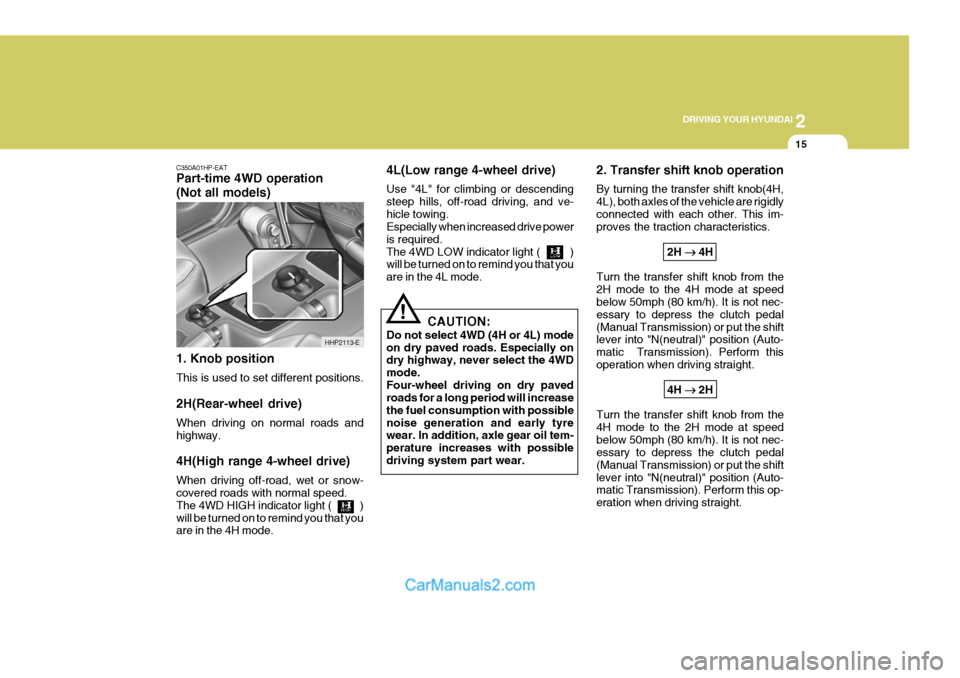
2
DRIVING YOUR HYUNDAI
15
C350A01HP-EAT Part-time 4WD operation (Not all models) 1. Knob position This is used to set different positions. 2H(Rear-wheel drive) When driving on normal roads and highway. 4H(High range 4-wheel drive) When driving off-road, wet or snow- covered roads with normal speed. The 4WD HIGH indicator light ( )will be turned on to remind you that you are in the 4H mode.
!
4L(Low range 4-wheel drive) Use "4L" for climbing or descending steep hills, off-road driving, and ve-hicle towing. Especially when increased drive power is required.The 4WD LOW indicator light ( ) will be turned on to remind you that you are in the 4L mode.
2. Transfer shift knob operation By turning the transfer shift knob(4H, 4L), both axles of the vehicle are rigidlyconnected with each other. This im- proves the traction characteristics.
2H ��
��
� 4H
Turn the transfer shift knob from the 2H mode to the 4H mode at speed below 50mph (80 km/h). It is not nec- essary to depress the clutch pedal(Manual Transmission) or put the shift lever into "N(neutral)" position (Auto- matic Transmission). Perform thisoperation when driving straight. 4H ��
��
� 2H
Turn the transfer shift knob from the4H mode to the 2H mode at speedbelow 50mph (80 km/h). It is not nec- essary to depress the clutch pedal (Manual Transmission) or put the shiftlever into "N(neutral)" position (Auto- matic Transmission). Perform this op- eration when driving straight.
CAUTION:
Do not select 4WD (4H or 4L) modeon dry paved roads. Especially on dry highway, never select the 4WD mode.Four-wheel driving on dry paved roads for a long period will increase the fuel consumption with possiblenoise generation and early tyre wear. In addition, axle gear oil tem- perature increases with possibledriving system part wear.
HHP2113-E
Page 429 of 539
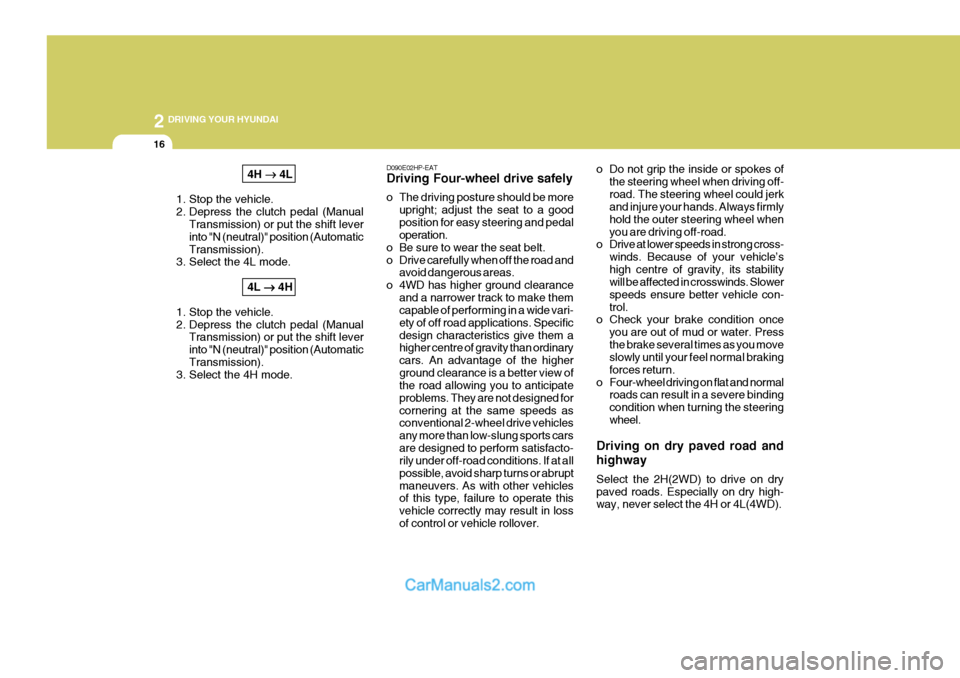
2 DRIVING YOUR HYUNDAI
16
4H ��
��
� 4L
1. Stop the vehicle.
2. Depress the clutch pedal (Manual Transmission) or put the shift leverinto "N (neutral)" position (AutomaticTransmission).
3. Select the 4L mode.
4L ��
��
� 4H
1. Stop the vehicle.
2. Depress the clutch pedal (Manual Transmission) or put the shift leverinto "N (neutral)" position (AutomaticTransmission).
3. Select the 4H mode.
D090E02HP-EAT Driving Four-wheel drive safely
o The driving posture should be more
upright; adjust the seat to a good position for easy steering and pedal operation.
o Be sure to wear the seat belt.
o Drive carefully when off the road and avoid dangerous areas.
o 4WD has higher ground clearance and a narrower track to make them capable of performing in a wide vari- ety of off road applications. Specificdesign characteristics give them a higher centre of gravity than ordinary cars. An advantage of the higherground clearance is a better view of the road allowing you to anticipate problems. They are not designed forcornering at the same speeds as conventional 2-wheel drive vehicles any more than low-slung sports carsare designed to perform satisfacto- rily under off-road conditions. If at all possible, avoid sharp turns or abruptmaneuvers. As with other vehicles of this type, failure to operate this vehicle correctly may result in lossof control or vehicle rollover. o Do not grip the inside or spokes of
the steering wheel when driving off-road. The steering wheel could jerk and injure your hands. Always firmly hold the outer steering wheel whenyou are driving off-road.
o Drive at lower speeds in strong cross-
winds. Because of your vehicle’shigh centre of gravity, its stability will be affected in crosswinds. Slower speeds ensure better vehicle con-trol.
o Check your brake condition once
you are out of mud or water. Pressthe brake several times as you move slowly until your feel normal braking forces return.
o Four-wheel driving on flat and normal roads can result in a severe bindingcondition when turning the steeringwheel.
Driving on dry paved road and highway Select the 2H(2WD) to drive on dry paved roads. Especially on dry high- way, never select the 4H or 4L(4WD).
Page 430 of 539
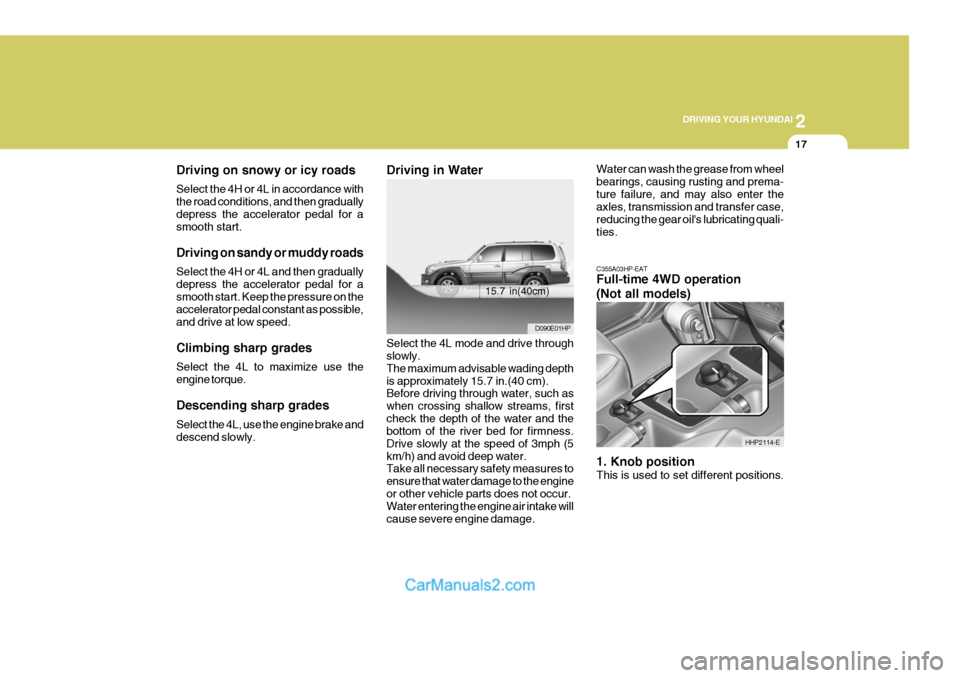
2
DRIVING YOUR HYUNDAI
17
C355A03HP-EAT Full-time 4WD operation (Not all models) 1. Knob position This is used to set different positions.
15.7 in(40cm) D090E01HP
HHP2114-E
Driving on snowy or icy roads Select the 4H or 4L in accordance with the road conditions, and then graduallydepress the accelerator pedal for a smooth start. Driving on sandy or muddy roads Select the 4H or 4L and then gradually depress the accelerator pedal for asmooth start. Keep the pressure on the accelerator pedal constant as possible, and drive at low speed. Climbing sharp grades Select the 4L to maximize use the engine torque. Descending sharp grades Select the 4L, use the engine brake and descend slowly.
Driving in Water
Water can wash the grease from wheelbearings, causing rusting and prema-ture failure, and may also enter the axles, transmission and transfer case, reducing the gear oil's lubricating quali-ties.
Select the 4L mode and drive through slowly. The maximum advisable wading depthis approximately 15.7 in.(40 cm). Before driving through water, such as when crossing shallow streams, firstcheck the depth of the water and the bottom of the river bed for firmness. Drive slowly at the speed of 3mph (5km/h) and avoid deep water. Take all necessary safety measures to ensure that water damage to the engineor other vehicle parts does not occur. Water entering the engine air intake will cause severe engine damage.